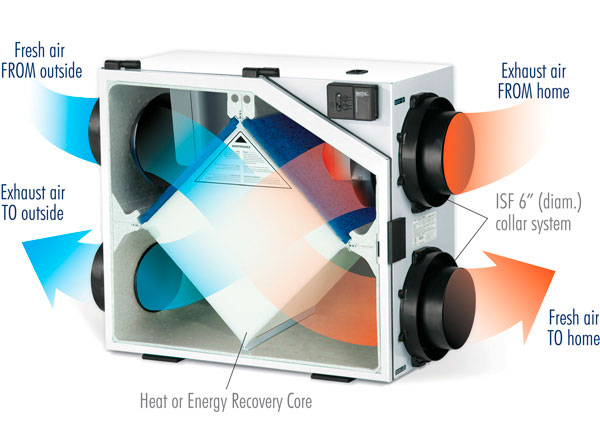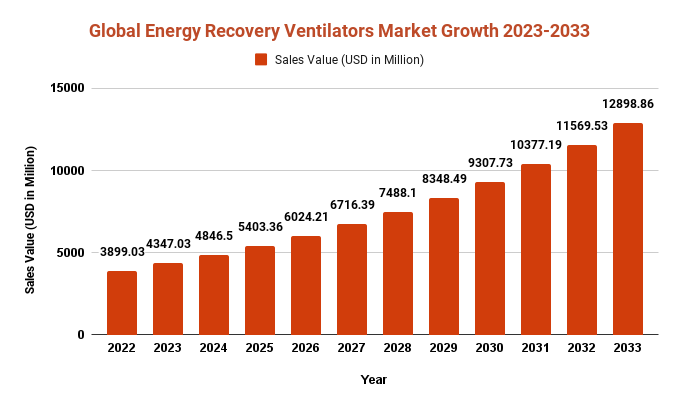Energy Recovery Ventilators Market Set to Grow at a CAGR of 11.49% from 2023 to 2033

Page Contents
Market Overview
Published Via 11Press: Energy Recovery Ventilators (ERVs) are mechanical ventilation systems designed to recover heat and/or moisture from an outgoing air stream and transfer it back into it. This process, known as heat or energy recovery, helps improve indoor air quality while reducing energy consumption. Energy Recovery Ventilators Market typically consist of a heat exchanger, air filters, fans, ductwork – with the heat exchanger at its heart responsible for transferring heat between outgoing and incoming streams; air filters remove contaminants from incoming air while fans move it through the system.
The Energy Recovery Ventilators Market size is expected to reach USD 12898.86 Mn by 2033, up from its current value of USD 3899.03 Mn in 2022, growing at an annual compound growth rate (CAGR) of 11.49% from 2023-2033.
ERVs are used in a range of settings, such as residential, commercial and industrial buildings. They're especially beneficial in buildings that are tightly sealed for energy efficiency because they help maintain healthy indoor air quality while reducing energy consumption. There are various ERVs on the market, such as plate heat exchangers, rotary wheel heat exchangers and run-around coil systems. Every type has its own advantages and drawbacks, so the decision on the type of system should be based on factors like the size of the building, climate conditions and intended use. In addition to improving indoor air quality and reducing energy consumption, ERVs also help ease strain on heating/cooling systems which in turn extends their lifespan and lowers maintenance expenses.
Key Takeaways
- Electrical Recirculated Ventilators (ERVs) are mechanical ventilation systems that capture heat and/or moisture from outgoing air and transfer it to incoming air. These systems include a heat exchanger, air filters, fans and ductwork. ERVs can be especially beneficial in buildings that are tightly sealed for energy efficiency since they help maintain healthy indoor air quality while cutting back on energy consumption.
- There are various ERVs, such as plate heat exchangers, rotary wheel heat exchangers and run-around coil systems. ERVs help reduce the strain on heating and cooling systems which in turn extends their lifespan and lowers maintenance expenses. ERVs are an efficient and effective way to enhance indoor air quality and reduce energy consumption in various settings.

Click Here To Access Sample Pages Of This Report: https://marketresearch.biz/report/energy-recovery-ventilators-market/request-sample/
Regional Snapshot
- North America:
Energy Recovery Ventilators (ERVs) are increasingly common in North America, especially areas with extreme weather. Many commercial and residential buildings here have tight building envelopes that require ventilation systems that can recover heat and moisture. As more energy-efficient buildings become commonplace, demand for ERVs will only grow. - Europe:
Energy efficiency is a top priority in Europe, and energy recovery ventilators (ERVs) are becoming more common as an effective way to reduce building energy usage. The market for ERVs in Europe is anticipated to expand due to government initiatives to promote energy-efficient buildings and increased awareness about indoor air quality. - Asia Pacific:
As awareness of indoor air quality and energy efficiency spreads throughout Asia Pacific, demand for ERVs is on the rise. This trend is especially evident in densely populated cities with high levels of air pollution such as Beijing, Delhi, and Shanghai. - Latin America:
The market for Energy Recovery Ventilators (ERVs) in Latin America is relatively small compared to other regions, but it is expected to expand as energy-efficient building codes and regulations become more widespread. Countries such as Brazil, Chile, and Mexico have seen an escalation in ERV popularity recently. - Middle East and Africa:
The demand for energy recovery ventilators (ERVs) in the Middle East and Africa is on the rise due to their ability to recover heat and moisture in hot climates. Countries such as Saudi Arabia, United Arab Emirates, and South Africa have all seen an uptick in ERV sales due to these factors.
Inquire Here & Query for report: https://marketresearch.biz/report/energy-recovery-ventilators-market/#inquiry
Drivers
- Energy codes and standards are becoming more stringent, necessitating buildings to meet specific efficiency criteria. Energy recovery ventilators offer a cost-effective solution for reducing energy consumption while satisfying these regulations. There is increasing concern about indoor air quality, especially in buildings with tight envelopes that trap pollutants and allergens. Energy recovery ventilators (ERVs) help improve this by taking away pollutants and allergens while introducing fresh air. There is a growing awareness about environmental issues, and many individuals and organizations are seeking ways to reduce their carbon footprint. Energy recovery ventilators (ERVs) are an efficient way to reduce energy consumption and greenhouse gas emissions.
- Energy recovery ventilators (ERVs) can help reduce the demand on heating and cooling systems, leading to cost-savings in maintenance expenses as well as energy consumption. ERVs can help prevent the spread of airborne illnesses and infections, making them a popular choice for healthcare facilities and other buildings where indoor air quality is critical. As the demand for sustainable and energy-efficient buildings grows, so too will the market for ERVs in coming years.
- ErVs work by using a heat exchanger to transfer energy from outgoing stale air to incoming fresh air. This heat exchanger consists of two distinct air streams that pass each other without mixing, so as the warm stale air leaves the building it passes through without mixing with it. Filtered and distributed throughout the building, this provides ample fresh air while minimising energy loss – helping maintain an inviting indoor climate while cutting back on energy consumption.
Restraints
- The initial expense of purchasing and installing ERVs can be substantial, particularly for larger buildings. This may pose a barrier to adoption for some building owners and operators. To guarantee an ERV's optimal performance, regular maintenance is necessary. This could include cleaning filters, replacing components, and conducting regular inspections. Over time, these costs can add up. EERVs can be intricate systems that necessitate specialized design and installation. This may make it challenging for some building owners and operators to select the appropriate system and guarantee its accurate installation.
- ERVs may not be as efficient in extreme climates such as cold or hot and humid environments where air streams have significant temperature and humidity differences. EERVs can produce noise, especially if not installed or maintained correctly. This noise pollution may create an inconvenience for building occupants and necessitate additional measures to mitigate it. Installing an ERV requires space, which may be an issue in buildings with limited mechanical space or retrofit applications where space is at a premium.
Opportunities
- As more individuals and organizations place emphasis on environmental sustainability, the demand for green buildings is on the rise. Energy recovery ventilators (ERVs) are an integral component of these buildings, so this trend is expected to fuel ERV demand. While ERVs have traditionally been utilized in commercial and industrial settings, there is now growing interest in using them in residential buildings to enhance indoor air quality and energy efficiency. This presents manufacturers and suppliers with an opportunity to expand into this residential market. Recent advances in ERV technology include more efficient heat exchangers, advanced controls and intelligent sensors. These advances could result in more effective and efficient ERVs, potentially leading to increased adoption.
- Many governments provide incentives and rebates for energy-efficient buildings and HVAC systems, helping reduce the cost of purchasing and installing ERVs and making them more appealing to building owners and operators. There is an unprecedented global construction boom, particularly in emerging regions like Asia and the Middle East. This presents ERV manufacturers and suppliers with an excellent opportunity to expand their businesses and penetrate new markets. The ongoing COVID-19 pandemic has highlighted the significance of indoor air quality in buildings. Energy recovery ventilators (ERVs) can help reduce the spread of airborne illnesses and infections, making them a great option for healthcare facilities and other buildings where indoor air quality is key.
Challenges
- Unfortunately, many building owners, operators, and occupants are unaware of the advantages of ERVs or how they work. This lack of understanding can be a deterrent to adoption. There is a lack of uniformity when it comes to ERV systems, including testing and certification protocols. This makes it challenging for building owners and operators to compare different options and guarantee they get the best performance and value from their investments. Retrofitting existing buildings with energy recovery ventilators (ERVs) can present unique challenges, especially in buildings with limited mechanical space or complex HVAC systems.
- ERVs require regular upkeep and cleaning in order to function optimally. This may present a challenge for building owners and operators with limited resources or expertise, particularly those without such resources. While energy recovery ventilators (ERVs) can provide significant energy savings over time, their initial cost may be higher than traditional HVAC systems. This could pose a barrier to adoption for building owners and operators with limited budgets, as ERVs tend to require more upfront investments than their traditional HVAC counterparts. ERVs may not be as effective in extreme climates or areas with unique weather patterns, such as high humidity or pollution levels. This could limit their applicability in certain regions or building types.
Market Segmentation
By Technology
- Plate Heat Exchange
- Rotary Heat Exchange
- Run Around Coil
- Heat Pipe Heat Exchanger
- Thermosiphon
- Others
By Type
- Wall Mounted
- Window Mounted
- Others
By Application
- Commercial
- Residential
- Industrial
Key Players
- Mitsubishi Electric Corporation Ltd. (Japan)
- Daikin industries Ltd. (Japan)
- United Technologies Corporation (U.S.)
- FUJITSU Ltd. (Japan)
- Nortek, Inc. (U.S.)
- LG Electronics (South Korea)
- Johnson Controls International PLC (Ireland)
- Blue Star Ltd. (India)
- Airxchange Inc. (U.S.)
- Munters Corporation (Sweden)
Report Scope
| Report Attribute | Details |
| Market size value in 2022 | USD 3899.03 Mn |
| Revenue forecast by 2033 | USD 12898.86 Mn |
| Growth Rate | CAGR Of 11.49% |
| Regions Covered | North America, Europe, Asia Pacific, Latin America, and Middle East & Africa, and Rest of the World |
| Historical Years | 2017-2022 |
| Base Year | 2022 |
| Estimated Year | 2023 |
| Short-Term Projection Year | 2028 |
| Long-Term Projected Year | 2033 |
Growing Demand => Request for Customization
Recent Developments
- ERCs are now being integrated with BAS for remote monitoring and control of ventilation systems, helping to optimize system performance and reduce energy consumption. Energy recovery ventilators (ERVs) are now equipped with more sophisticated control strategies that give them greater flexibility during operation. This helps boost energy efficiency and lower operating costs. ERV manufacturers are exploring the use of cutting-edge materials and designs, such as advanced heat exchangers and regenerative desiccant wheels, to enhance system performance and efficiency.
- With the ongoing COVID-19 pandemic, there is an increasing emphasis on indoor air quality and how ERVs can improve it while decreasing the spread of airborne illnesses. Governments across the world are offering incentives and implementing regulations to promote energy-efficient building systems, such as ERVs. This is expected to fuel demand for ERVs in the upcoming years. ERV manufacturers are expanding into residential and light commercial buildings, which is expected to drive growth in the ERV market as more building owners and operators recognize its advantages.
Key Questions
1. What are the advantages of Energy Recovery Ventilators and how do they operate?
Energy Recovery Ventilators (ERVs) are a type of ventilation system that help improve indoor air quality by bringing in fresh outdoor air while also recovering the energy from the outgoing stale air. This exchange of air helps reduce the buildup of pollutants, allergens, and other harmful substances in the air.
2. How do Energy Recovery Ventilators compare to other ventilation systems?
ERVs recover the energy from the outgoing stale air and transfer it to the incoming fresh air. This makes ERVs more energy-efficient than other ventilation systems that simply exhaust stale air and bring in fresh air.
3. What factors should be taken into account when selecting an Energy Recovery Ventilator?
The size and ventilation needs of the building will determine the capacity of the ERV required. The ERV should be able to provide enough fresh air for the building while also recovering enough energy from the stale air to make the system energy-efficient.
4. What maintenance requirements exist for Energy Recovery Ventilators?
The ERV should be cleaned regularly to remove any buildup of dirt, dust, or other contaminants. This can include cleaning the heat exchanger, fans, and other components.
5. What regulations and standards exist for Energy Recovery Ventilators, and how do they differ by region?
Regulations and standards for Energy Recovery Ventilators (ERVs) can vary by region and country. Many countries have energy efficiency standards for ERVs, such as the Energy Star program in the United States, which sets minimum energy efficiency requirements for ERVs.
6. How can Energy Recovery Ventilators be integrated with Building Automation Systems?
Energy Recovery Ventilators (ERVs) can be integrated with Building Automation Systems (BAS) to provide efficient and effective ventilation to buildings. The integration of ERVs with BAS can help to optimize the performance of HVAC systems and reduce energy consumption.
7. What are the current trends and developments in the Energy Recovery Ventilator market?
The demand for ERVs in residential applications is increasing due to the need for fresh air and better indoor air quality. ERVs can help reduce the energy consumption of HVAC systems by recovering energy from the outgoing air and using it to precondition incoming air.
8. How do Energy Recovery Ventilators contribute to indoor air quality?
ERVs can remove pollutants such as dust, dirt, pollen, and other airborne particles from the incoming air. The filters in the ERV trap these pollutants, preventing them from entering the indoor environment.
9. What are the anticipated future advancements in Energy Recovery Ventilator technology and applications?
Smart controls and sensors can help to optimize ERV performance and energy efficiency by adjusting ventilation rates based on occupancy, temperature, humidity, and outdoor air quality. This can help to further reduce energy consumption and improve indoor air quality.
Contact us
Contact Person: Mr. Lawrence John
Marketresearch.Biz (Powered By Prudour Pvt. Ltd.)
Tel: +1 (347) 796-4335
Send Email: [email protected]
The team behind market.us, marketresearch.biz, market.biz and more. Our purpose is to keep our customers ahead of the game with regard to the markets. They may fluctuate up or down, but we will help you to stay ahead of the curve in these market fluctuations. Our consistent growth and ability to deliver in-depth analyses and market insight has engaged genuine market players. They have faith in us to offer the data and information they require to make balanced and decisive marketing decisions.



